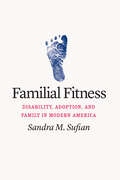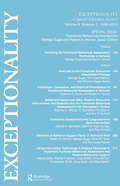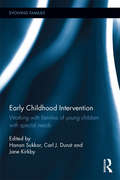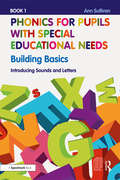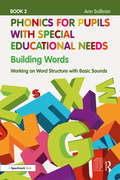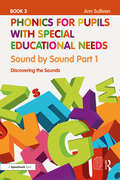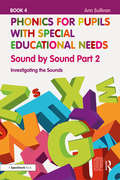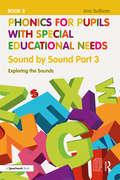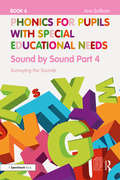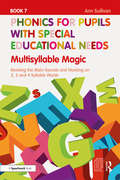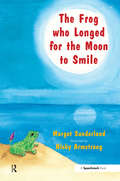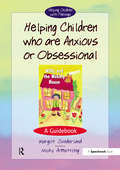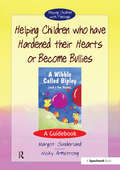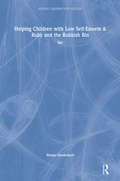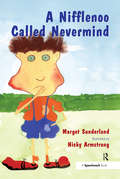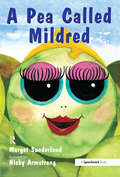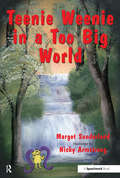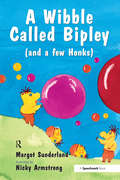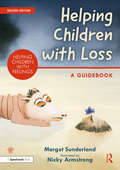- Table View
- List View
Familial Fitness: Disability, Adoption, and Family in Modern America
by Sandra M. SufianThe first social history of disability and difference in American adoption, from the Progressive Era to the end of the twentieth century. Disability and child welfare, together and apart, are major concerns in American society. Today, about 125,000 children in foster care are eligible and waiting for adoption, and while many children wait more than two years to be adopted, children with disabilities wait even longer. In Familial Fitness, Sandra M. Sufian uncovers how disability operates as a fundamental category in the making of the American family, tracing major shifts in policy, practice, and attitudes about the adoptability of disabled children over the course of the twentieth century. Chronicling the long, complex history of disability, Familial Fitness explores how notions and practices of adoption have—and haven’t—accommodated disability, and how the language of risk enters into that complicated relationship. We see how the field of adoption moved from widely excluding children with disabilities in the early twentieth century to partially including them at its close. As Sufian traces this historical process, she examines the forces that shaped, and continue to shape, access to the social institution of family and invites readers to rethink the meaning of family itself.
Functional Behavioral Assessment: A Special Issue of exceptionality
by George Sugai Robert H. HornerPublished in 2000, Functional Behavioral Assessment is a valuable contribution to the field of Education.
Functional Behavioral Assessment: A Special Issue of exceptionality
by George Sugai Robert H. HornerPublished in 2000, Functional Behavioral Assessment is a valuable contribution to the field of Education.
Early Childhood Intervention: Working with Families of Young Children with Special Needs (Evolving Families)
by Hanan Sukkar Carl J. Dunst Jane KirkbyEarly childhood is considered a critical but often vulnerable period in a child’s development where early identification and intervention can be crucial for improving children’s developmental outcomes. Systems and family-centred perspectives are vital to support families and build their capacities to lead normalized lives with improved family quality of life. This book explores the family-centred practices and systems factors which influence families’ experiences raising children with complex needs. It also considers the ways in which professionals can work with families to build and support parent and child competence. Conceptual and practical work from Australia, Canada, Europe and the United States present descriptions of and implications for different family system frameworks and early-childhood programs. Contributors in this edited volume bring together contemporary information that bridges the research to practice gap in supporting families of young children with disabilities or delays. Chapters include: Early Intervention for Young Children with Developmental Delays: Contributions of the Developmental Systems Approach Family Composition and Family Needs in Australia: What Makes a Family? Working with Families in Early Childhood Intervention: Family-Centred Practices in an Individualised Funding Landscape Family Systems and Family-Centred Intervention Practices in Portugal and Spain: Iberian Reflections on Early Childhood Intervention This book will attract the attention scholars of Parenting and Families; Child Development and Childcare.
Early Childhood Intervention: Working with Families of Young Children with Special Needs (Evolving Families)
by Hanan Sukkar Carl J. Dunst Jane KirkbyEarly childhood is considered a critical but often vulnerable period in a child’s development where early identification and intervention can be crucial for improving children’s developmental outcomes. Systems and family-centred perspectives are vital to support families and build their capacities to lead normalized lives with improved family quality of life. This book explores the family-centred practices and systems factors which influence families’ experiences raising children with complex needs. It also considers the ways in which professionals can work with families to build and support parent and child competence. Conceptual and practical work from Australia, Canada, Europe and the United States present descriptions of and implications for different family system frameworks and early-childhood programs. Contributors in this edited volume bring together contemporary information that bridges the research to practice gap in supporting families of young children with disabilities or delays. Chapters include: Early Intervention for Young Children with Developmental Delays: Contributions of the Developmental Systems Approach Family Composition and Family Needs in Australia: What Makes a Family? Working with Families in Early Childhood Intervention: Family-Centred Practices in an Individualised Funding Landscape Family Systems and Family-Centred Intervention Practices in Portugal and Spain: Iberian Reflections on Early Childhood Intervention This book will attract the attention scholars of Parenting and Families; Child Development and Childcare.
Phonics for Pupils with Special Educational Needs Book 1: Introducing Sounds and Letters (Phonics for Pupils with Special Educational Needs)
by Ann SullivanPhonics for Pupils with Special Educational Needs is a complete, structured, multisensory programme for teaching reading and spelling, making it fun and accessible for all. This fantastic seven-part resource offers a refreshingly simple approach to the teaching of phonics, alongside activities to develop auditory and visual perceptual skills. Specifically designed to meet the needs of pupils of any age with special educational needs, the books break down phonics into manageable core elements and provide a huge wealth of resources to support teachers in teaching reading and spelling. Book 1: Building Basics introduces basic sounds and explores their relationship with letters. It focuses on sounds and letters where there is a simple 1:1 correspondence between the two, and explores the sounds in simple words that follow the pattern of vowel-consonant or consonant-vowel-consonant. Sounds are grouped into seven sets, with each set containing more than 50 engaging activities, including: sound story, dynamic blending, reading race, spot the word and spelling challenge. Thorough guidance is provided on how to deliver each activity, as well as a lesson planner template, handy word lists and posters for teachers and teaching assistants to use to support learning. Each book in the series gradually builds on children’s understanding of sounds and letters and provides scaffolded support for children to learn about every sound in the English language. Offering tried and tested material which can be photocopied for each use, this is an invaluable resource to simplify phonics teaching for teachers and teaching assistants and provide fun new ways of learning phonics for all children.
Phonics for Pupils with Special Educational Needs Book 2: Working on Word Structure with Basic Sounds (Phonics for Pupils with Special Educational Needs)
by Ann SullivanPhonics for Pupils with Special Educational Needs is a complete, structured, multisensory programme for teaching reading and spelling, making it fun and accessible for all. This fantastic seven-part resource offers a refreshingly simple approach to the teaching of phonics, alongside activities to develop auditory and visual perceptual skills. Specifically designed to meet the needs of pupils with special educational needs of any age, the books break down phonics into manageable core elements and provide a huge wealth of resources to support teachers in teaching reading and spelling. Book 2: Building Words reinforces pupils’ knowledge of the basic sounds explored in Book 1 and uses these to build words with a more complex structure. It focuses on words of three, four and five sounds, and words are grouped according to their pattern of vowels and consonants. Each chapter contains more than 50 engaging activities, including: odd one out, sound boxes, busy words, oops! correct the spelling and writing challenge. An additional chapter on capital letters allows pupils to practice identifying and working with these letters. Thorough guidance is provided on how to deliver each activity, as well as a lesson planner template, handy word lists and posters for teachers to use to support learning. Each book in the series gradually builds on children’s understanding of sounds and letters and provides scaffolded support for children to learn about every sound in the English language. Offering tried and tested material which can be photocopied for each use, this is an invaluable resource to simplify phonics teaching for teachers and teaching assistants and provide fun new ways of learning phonics for all children.
Phonics for Pupils with Special Educational Needs Book 3: Discovering the Sounds (Phonics for Pupils with Special Educational Needs)
by Ann SullivanPhonics for Pupils with Special Educational Needs is a complete, structured, multisensory programme for teaching reading and spelling, making it fun and accessible for all. This fantastic seven-part resource offers a refreshingly simple approach to the teaching of phonics, alongside activities to develop auditory and visual perceptual skills. Specifically designed to meet the needs of pupils with special educational needs of any age, the books break down phonics into manageable core elements and provide a huge wealth of resources to support teachers in teaching reading and spelling. Book 3: Sound by Sound, Part 1 focuses on discovering complex sounds and their relationship with letters and letter combinations. Each chapter explores a key sound (sh/ th/ ng/ ch/ k/ qu/ f/ l/ s) and contains over 40 engaging activities, including: sound exchange, word scramble, spot the spelling, word detective and writing challenge. Thorough guidance is provided on how to deliver each activity, as well a lesson planner template, a handy list of high frequency words and posters for teachers and teaching assistants to use to support learning. Each book in the series gradually builds on children’s understanding of sounds and letters and provides scaffolded support for children to learn about every sound in the English language. Offering tried and tested material which can be photocopied for each use, this is an invaluable resource to simplify phonics teaching for teachers and teaching assistants and provide fun new ways of learning phonics for all children.
Phonics for Pupils with Special Educational Needs Book 4: Investigating the Sounds (Phonics for Pupils with Special Educational Needs)
by Ann SullivanPhonics for Pupils with Special Educational Needs is a complete, structured, multisensory programme for teaching reading and spelling, making it fun and accessible for all. This fantastic seven-part resource offers a refreshingly simple approach to the teaching of phonics, alongside activities to develop auditory and visual perceptual skills. Specifically designed to meet the needs of pupils of any age with special educational needs, the books break down phonics into manageable core elements and provide a huge wealth of resources to support teachers in teaching reading and spelling. Book 4: Sound by Sound Part 2 focuses on investigating complex sounds and their relationship with letters and letter combinations. Each chapter explores a key sound (o-e/ z/ ee/ a-e/ er/ e/ ow) and contains over 40 engaging activities, including: sound sums, word tech, word tracker, making better sentences and spelling challenge. Thorough guidance is provided on how to deliver each activity, as well a lesson planner template, a handy list of high frequency words and posters for teachers and teaching assistants to use to support learning. Each book in the series gradually builds on children’s understanding of sounds and letters and provides scaffolded support for children to learn about every sound in the English language. Offering tried and tested material which can be photocopied for each use, this is an invaluable resource to simplify phonics teaching for teachers and teaching assistants and provide fun new ways of learning phonics for all children.
Phonics for Pupils with Special Educational Needs Book 5: Exploring the Sounds (Phonics for Pupils with Special Educational Needs)
by Ann SullivanPhonics for Pupils with Special Educational Needs is a complete, structured, multisensory programme for teaching reading and spelling, making it fun and accessible for all. This fantastic seven-part resource offers a refreshingly simple approach to the teaching of phonics, alongside activities to develop auditory and visual perceptual skills. Specifically designed to meet the needs of pupils of any age with special educational needs, the books break down phonics into manageable core elements and provide a huge wealth of resources to support teachers in teaching reading and spelling. Book 5: Sound by Sound Part 3 focuses on exploring complex sounds and their relationship with letters and letter combinations. Each chapter explores a key sound (oy/ oo/ u/ i-e/ aw/ air/ ar) and contains over 40 engaging activities, including: reading race, bits missing, spot the spelling, word detective and writing challenge. Thorough guidance is provided on how to deliver each activity, as well a lesson planner template, a handy list of high frequency words and posters for teachers and teaching assistants to use to support learning. Each book in the series gradually builds on children’s understanding of sounds and letters and provides scaffolded support for children to learn about every sound in the English language. Offering tried and tested material which can be photocopied for each use, this is an invaluable resource to simplify phonics teaching for teachers and teaching assistants and provide fun new ways of learning phonics for all children.
Phonics for Pupils with Special Educational Needs Book 6: Surveying the Sounds (Phonics for Pupils with Special Educational Needs)
by Ann SullivanPhonics for Pupils with Special Educational Needs is a complete, structured, multisensory programme for teaching reading and spelling, making it fun and accessible for all. This fantastic seven-part resource offers a refreshingly simple approach to the teaching of phonics, alongside activities to develop auditory and visual perceptual skills. Specifically designed to meet the needs of pupils of any age with special educational needs, the books break down phonics into manageable core elements and provide a huge wealth of resources to support teachers in teaching reading and spelling. Book 6: Sound by Sound Part 4 focuses on surveying complex sounds and their relationship with letters and letter combinations. Each chapter explores a key sound (s/ l/ b&d/ o/ i/ u-e) as well as looking at consonants in greater detail and contains over 40 engaging activities including sound story, flippies, sound swap, word tech and spelling challenge. Thorough guidance is provided on how to deliver each activity, as well a lesson planner template, a handy list of high frequency words and posters for teachers and teaching assistants to use to support learning. Each book in the series gradually builds on children’s understanding of sounds and letters and provides scaffolded support for children to learn about every sound in the English language. Offering tried and tested material which can be photocopied for each of use, this is an invaluable resource to simplify phonics teaching for teachers and teaching assistants and provide fun new ways of learning phonics for all children.
Phonics for Pupils with Special Educational Needs Book 7: Revising the Main Sounds and Working on 2, 3 and 4 Syllable Words (Phonics for Pupils with Special Educational Needs)
by Ann SullivanPhonics for Pupils with Special Educational Needs is a complete, structured, multisensory programme for teaching reading and spelling, making it fun and accessible for all. This fantastic seven-part resource offers a refreshingly simple approach to the teaching of phonics, alongside activities to develop auditory and visual perceptual skills. Specifically designed to meet the needs of pupils of any age with special educational needs, the books break down phonics into manageable core elements and provide a huge wealth of resources to support teachers in teaching reading and spelling. Book 7: Multisyllable Magic focuses on revising the main complex sounds from previous books and working on words with 2, 3 and 4 syllables. It also explores words with key suffixes (-tion/ -sion/ -ture/ -sure/ -cious/ -cial). Each chapter contains 10 engaging activities, including syllable jigsaw, sounds like a syllable, syllable trap and spelling challenge, plus handy highlighted word cards. Thorough guidance is provided on how to deliver each activity, as well as a lesson planner template to support learning. Each book in the series gradually builds on children’s understanding of sounds and letters and provides scaffolded support for children to learn about every sound in the English language. Offering tried and tested material which can be photocopied for each use, this is an invaluable resource to simplify phonics teaching for teachers and teaching assistants and provide fun new ways of learning phonics for all children.
Bothered: Helping Teenagers Talk About Their Feelings
by Margot SunderlandAt this challenging developmental stage, when teenagers are finding things difficult, this book can really help. It is full of tools and techniques of what to say and how to be, enabling teenagers to move from unhappiness, poor functioning or learning blocks, to a place of self-awareness, self esteem and the ability to thrive. The first part of the book offers a key assessment tool, namely 'The Teenager Well-Being Profile'. This is designed for people to easily assess just how well the teenager is doing in their life emotionally and relationally. If the teenager is messing up in some areas, the Well-Being Profile will show clearly which life skill he or she has not yet mastered. The accompanying, empowering worksheets address key feelings, issues and concerns common to teenagers. The worksheets enable adults to be with the teenager in a confident, non-embarrassing and effective way so that the conversation flows. This book provides a real opportunity for transformational conversations that will really make a difference.
The Frog Who Longed for the Moon to Smile: A Story for Children Who Yearn for Someone They Love (Helping Children with Feelings)
by Margot SunderlandA story for children who yearn for someone they love. Frog is very much in love with the moon because she once smiled at him. So now he spends all his time dreaming about her. He waits and waits for her to smile at him again. One day a wise and friendly crow helps frog to see how he is wasting his life away. All the time he has been facing the place of very little, he's had his back to the place of plenty.
Helping Children Who are Anxious or Obsessional: A Guidebook (Helping Children with Feelings)
by Margot SunderlandThis is a guidebook to help children who: are insecure or worry too much; suffer from phobias or nightmares; find it difficult to concentrate to let go and have fun; have suffered a trauma; are worryingly good or seem like little adults; use order and routine as a way of coping with 'messy' feelings; retreat into dullness as a way of managing their being in the world; and, develop obsessive-compulsive behaviour in order to ward off their too-powerful feelings.
Helping Children Who are Anxious or Obsessional: A Guidebook (Helping Children with Feelings)
by Margot SunderlandThis is a guidebook to help children who: are insecure or worry too much; suffer from phobias or nightmares; find it difficult to concentrate to let go and have fun; have suffered a trauma; are worryingly good or seem like little adults; use order and routine as a way of coping with 'messy' feelings; retreat into dullness as a way of managing their being in the world; and, develop obsessive-compulsive behaviour in order to ward off their too-powerful feelings.
Helping Children who have hardened their hearts or become bullies: A Guidebook (Helping Children with Feelings)
by Margot SunderlandThis is a guidebook to help children who: - bully or take revenge on others for the pain they have felt themselves - have become very defensive because something too painful has happened to them - have hardened their hearts because they have: been too hurt in love; met with too much harshness; witnessed parental violence; been repeatedly hit; been shamed or humiliated; or - had too many experiences of not being responded to - think they have lost their parent's love to someone else and have hardened their heart.
Helping Children with Low Self-Esteem & Ruby and the Rubbish Bin: Set (Helping Children with Feelings)
by Margot SunderlandThis practical guidebook, with a beautifully-illustrated storybook, enables teachers, parents and professionals to help children aged 4-12 connect with unresolved feelings affecting their behaviour. Helping Children with Low Self-Esteem is a guidebook to help children who: don't like themselves or feel there is something fundamentally wrong with them have been deeply shamed have received too much criticism or haven't been encouraged enough let people treat them badly because they feel they don't deserve better do not accept praise or appreciation because they feel they don't deserve it feel defeated by life, fundamentally unimportant, unwanted or unlovable bully because they think they are worthless or think they are worthless because they are bullied and, feel they don't belong or do not seek friends because they think no-one would want to be their friend. Ruby and the Rubbish Bin is a story for children with low self-esteem. Ruby hates herself so much that she often feels more like a piece of rubbish than a little girl. Sometimes Ruby feels so miserable that she wants to sleep and sleep and never wake up again. Then Ruby meets Dot and, over time, Dot helps Ruby to move from self-hate to self-respect. After a very important dream, and help from Dot, Ruby finds her voice and her anger, and stands up to the bullies. She makes new friends and knows what it's like to feel happy for the first time in her life.
A Nifflenoo Called Nevermind: A Story for Children Who Bottle Up Their Feelings (Helping Children with Feelings)
by Margot SunderlandA story for children who bottle up their feelings. Nevermind always carries on whatever happens! Each time something horrible happens to him he just tucks his feelings away and carries on with life. Find out what happens to Nevermind and how he begins to understand that his feelings do matter, how he learns to express them and stand up for himself.
A Pea Called Mildred: A Story to Help Children Pursue Their Hopes and Dreams (Helping Children with Feelings)
by Margot SunderlandA story to help children pursue their hopes and dreams. Mildred is a pea with dreams. She has great plans for her pea life. However, people are always telling her that dreams are pointless as she is just another ordinary pea. Eventually, with the help of a kind person along the way, Mildred ends up doing exactly what she has always dreamed of doing.
Teenie Weenie in a Too Big World: A Story for Fearful Children (Helping Children with Feelings)
by Margot Sunderland(A story for fearful children) One day Teenie Weenie finds himself in a scrumbly screechy place. It is full of noises and crashes and things that swoop and scratch. The worse it gets, the smaller Teenie Weenie feels. After a while, he feels so small that the tiniest insect tries to eat him up. Teenie Weenie feels terrified and desperately alone. But after a while along strolls a Wip-Wop bird who invites Teenie Weenie to come and have a chocolate muffin in his tree house. With the Wip Wop bird and his friend Hoggie, Teenie Weenie learns for the first time in his life all about the power of TOGETHER. He comes to know how very different things look when it's an US not just a ME. And so after that, whenever Teenie Weenie finds himself struggling alone with something too difficult or too frightening, he goes off and finds some TOGETHER.
Teenie Weenie in a Too Big World: A Story for Fearful Children (Helping Children with Feelings)
by Margot Sunderland(A story for fearful children) One day Teenie Weenie finds himself in a scrumbly screechy place. It is full of noises and crashes and things that swoop and scratch. The worse it gets, the smaller Teenie Weenie feels. After a while, he feels so small that the tiniest insect tries to eat him up. Teenie Weenie feels terrified and desperately alone. But after a while along strolls a Wip-Wop bird who invites Teenie Weenie to come and have a chocolate muffin in his tree house. With the Wip Wop bird and his friend Hoggie, Teenie Weenie learns for the first time in his life all about the power of TOGETHER. He comes to know how very different things look when it's an US not just a ME. And so after that, whenever Teenie Weenie finds himself struggling alone with something too difficult or too frightening, he goes off and finds some TOGETHER.
A Wibble Called Bipley: A Story for Children Who Have Hardened Their Hearts or Becomes Bullies (Helping Children with Feelings)
by Margot SunderlandA story for children who have hardened their hearts or become bullies. Bipley is a warm cuddly creature, but someone has broken his heart. He feels so hurt that he decides it is just too painful to ever love again. When he meets some big tough Honks in the wood, they teach him how to harden his heart so that he doesn't have to feel hurt any more. Luckily Bipley meets some creatures who teach him how he can protect himself without hardening his heart.
The Day the Sea Went Out and Never Came Back: A Story for Children Who Have Lost Someone They Love (Helping Children with Feelings)
by Margot Sunderland Nicky ArmstrongEric is a sand dragon who loves the sea very much. Each day, he watches it go out, knowing that it will return. But one day, Eric waits and waits, but it does not come back. He falls on the sand, feeling as if he has lost everything. Eric wants to shut himself off from his feelings, but eventually spots a little wildflower growing, and another, and another. He builds a rock pool garden, in memory of the sea that he loves, and learns that it is much better to feel the full pain of his loss, instead of closing his heart. The Day the Sea Went Out and Never Came Back is a story for children who have lost someone they love. The beautiful illustrations and sensitively written story offer a wealth of opportunities to begin a conversation about the difficult emotions that can follow a loss, helping children to acknowledge and express their emotions. The story shows them that it is brave to feel sad, that they are surrounded by support, and that memories of a loved one are a special treasure that can never be lost. Ideal for starting conversations about grief and sadness, this is an essential resource for anybody supporting children aged 4-12 who have experienced loss.
Helping Children with Loss: A Guidebook (Helping Children with Feelings)
by Margot Sunderland Nicky ArmstrongNow in a fully updated second edition, this professional guidebook has been created to help adults provide emotional support for children who have experienced the loss of somebody they know, or something they loved. Written in an accessible style and with a sensitive tone, Helping Children with Loss provides adults with a rich vocabulary for mental states and painful emotions, paving the way for meaningful and healing conversations with children who are struggling with difficult feelings. Practical activities provide opportunities for conversation and will empower the child to find creative and imaginative ways of expressing themselves when words fail. Key features of this resource include: Targeted advice for children who defend against feeling their painful feelings by dissociating from grief Tools and strategies for helping children cope with loss, including engaging activities to help children explore their feelings in a non-threatening way Photocopiable and downloadable resources to help facilitate support Written by a leading child psychotherapist with over thirty years’ experience, this book will support children to develop emotional literacy and connect with unresolved feelings affecting their behaviour. It is an essential resource for anybody supporting children aged 4-12 who have experienced loss.
